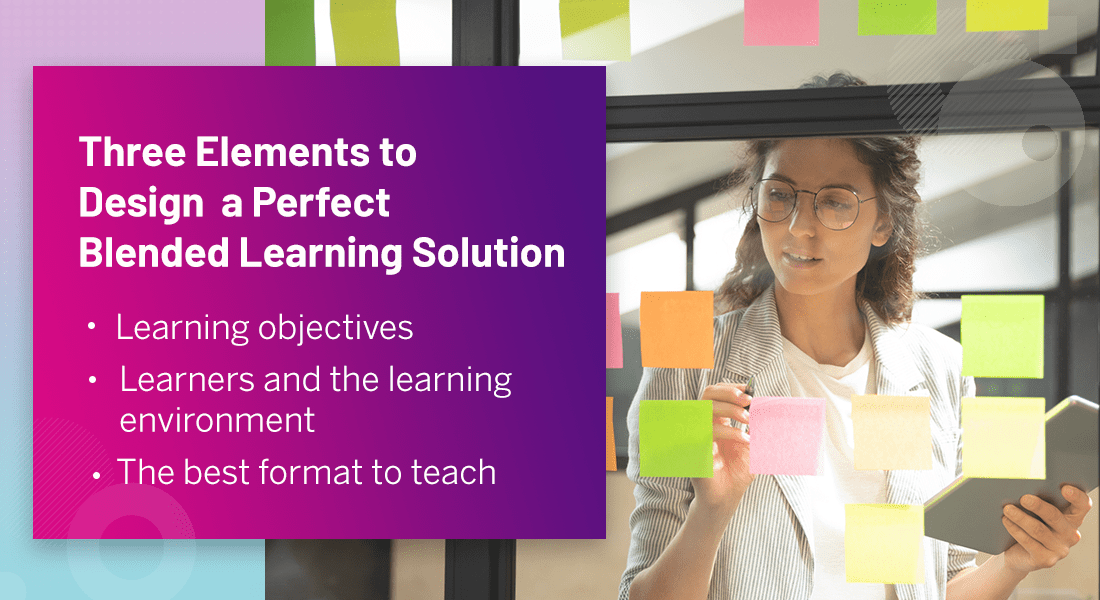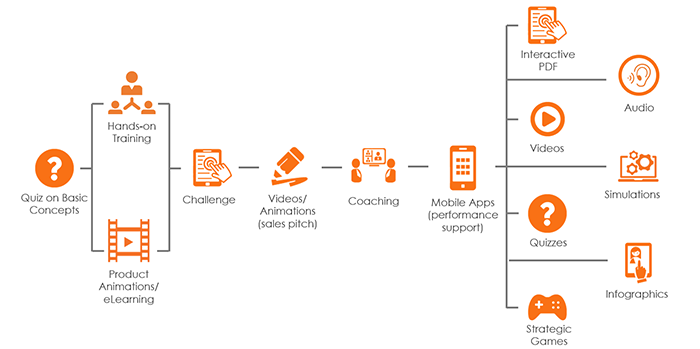3 Vital Considerations to Get Blended Learning Right

Just as you need to follow the recipe to the tee when baking a cake (exact amounts of ingredients, temperature setting, etc.), you also need to keep in mind a few factors when designing blended learning for your employee training. And if you don’t do it right, you might have to do the same thing with it that you do to a cake that looks and tastes awful – just dump it!

What is Blended Learning?
But before that, let’s define what we mean by blended learning. Simply put, blended learning is a training approach that uses a mix of face-to-face classroom-based training and online training programs to maximize learning.
|
Blended learning = Instructor-Led Training + Online Learning (synchronous and asynchronous) + Performance Support |
And as it is a hybrid of traditional classroom training and eLearning, a well thought out blended solution will offer the benefits of both training formats.
The trick is to use the right format at the right time at the right place in training. And that’s what I’ll be discussing in this blog – the 3 vital considerations to get your blended learning right!
What Does it Take to Create a Perfect Blended Learning Solution?
We would need to know:
- What we want employees (learners) to do after the training
- The learners and the learning environment
- The best format to train them
Three Aspects You Should Know to Get Blended Learning Right
The Learning Objectives
The learning objectives (what we want learners to be able to do by the end of the training) should be the most important factor while designing the blend. Don’t go for specific technologies just because they look good or are the ‘in’ thing. Focus instead on elements that will help you achieve the learning objectives.
Training is expected to provide employees the ability to perform some tasks that will help attain organizational objectives. A job task inventory will help you identify what you want employees to do as part of their jobs and choose the best way to help them learn to do those tasks.
Once you have identified the job tasks, you need to categorize them based on four critical parameters:
- Frequency: How often the task is performed on the job
- Importance: How important the task is to the overall effectiveness of performing the job
- Learning: How difficult the task is to learn
- Risk: What is the risk associated with performing the task incorrectly
Interpreting the Matrix
So, for a job task that ranks high on all four parameters, training should be designed to include:
- Training to provide information, demonstrations, plenty of opportunities for practice, coaching and feedback, and assessments
- Mentoring and coaching – on-the-job training, just-in-time learning
- eLearning with high interactivity, scenarios, and coaching and feedback with remediation
- Social learning – collaboration, sharing, communication, support
Similarly, for a job task that ranks low on all parameters, you can simply:
- Opt for performance support
- Avoid training – go for providing information, self-study, and social learning
I repeat, let the performance (work tasks) drive your blended solution, not the technology!
→ Download Checklist: Is Blended Learning Right For Your Corporate Training?
The Learners (and the Learning Environment)
Before designing the blend, carefully analyze the target audience – their preferences and learning environments. If learners are comfortable attending regular training sessions, instructor-led training is your best bet, either face to face or virtual classrooms.

The format would also depend on how comfortable learners are with technology. If learners are not very tech savvy, an eLearning course with complex interactivities would not be right for them. On the other hand, for the Gen Y and Gen Z workforce, expert at using electronic gadgets and preferring to access courses through their mobile devices, eLearning is the best option with online programs containing games and videos to keep them engaged.
And when it comes to training your sales personnel who are constantly on the move, the blended learning solution should contain less of formal long-winded training (like classroom sessions or long eLearning courses) and include a lot of microlearning which is short, focused on a single learning objective, and compatible with mobile devices. The training would also include a lot of just-in-time learning, including videos, quizzes, infographics, simulations, etc.
Here is a sample blended learning roadmap for product training aimed at sales personnel.

The Best Format to Teach
It’s important to choose the training format based on the training need, learner profile, and the learning environment – form should always follow function (and not the other way around)!
| Training Methods | Blended Learning Formats |
| Formal Training |
|
| Self-directed Learning |
|
| Just-in-time Training |
|
| Social Learning |
|
| Performance Support |
|
A topic that would be best addressed by group discussions is an obvious choice for the classroom and a topic that’s best taught through scenarios should be delivered online.
Complex concepts could be reserved for the classroom, with eLearning courses used to complement the learning from the classroom. For a training program on a piece of new equipment, classroom sessions and workshops could be used effectively to train on underlying concepts and handling of the equipment. Then eLearning modules with simulations can be used to provide learners opportunities to practice the steps in handling the machinery; lastly, bite-sized microlearning could be used to act as ready references to the concepts learnt.
When content is highly technical, you might want to go for collaborative learning with personalized interventions where learners can interact with experts on discussion platforms or chats.
Parting Thoughts
There you have it, 3 vital considerations you should discuss with your stakeholders to ensure your blended learning solution offers the right mix of training formats to help your employees achieve your organizational goals. Are you still confused if blended learning serves your corporate training needs? Download this checklist to figure it out and make informed decisions.
Editor’s note: This post was originally published in 2013 and has been updated for comprehensiveness.



![4 Reasons Why Blended Learning Can Change the Game [VIDEO]](https://blog.commlabindia.com/hubfs/Imported_Blog_Media/4-Reasons-Why-Blended-Learning-Can-Change-the-Game.jpg)

